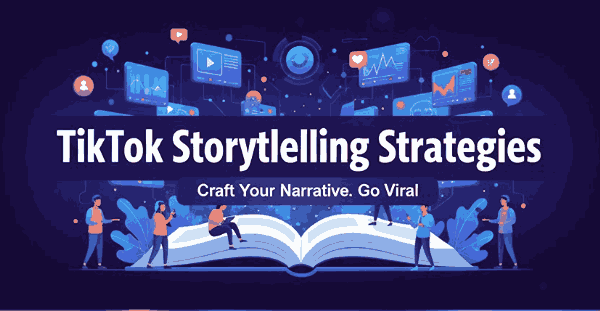
Table of Contents
- Introduction: Why Storytelling Matters on TikTok
- The Science & Research Behind TikTok Storytelling
- Core Principles of Effective TikTok Stories
- 3.1 Hook Quickly & Clearly
- 3.2 Use a Narrative Arc (Beginning, Middle, End)
- 3.3 Add Tension, Surprise, or Conflict
- 3.4 Strong Emotional or Value-Driven Message
- 3.5 Use Visuals, Text Overlays & Transitions
- 3.6 Close with a Clear Call to Action
- Formats & Types of TikTok Stories That Work
- How Creators Use Storytelling to Amplify Brand & Personality
- Applying Storytelling to Font & Design Content
- Font Mockup Ideas with Your Fonts
- Common Pitfalls to Avoid
- Final Tips & Next Steps
- References
1. Introduction: Why Matters on TikTok Storytelling Strategies
TikTok Storytelling Strategies is more than just trends and viral dances. At its heart, it’s a storytelling platform—users scroll not just for movement, but for meaning. Even in the span of 15–60 seconds, creators who tell a compelling micro-story often outperform flashy visuals without narrative.
For creative brands and font sellers, mastering TikTok storytelling strategies helps you transform mere exposure into emotional resonance, brand recall, and customer action.

2. The Science & Research Behind TikTok Storytelling Strategies
Storytelling is not just a buzzword—research supports its effectiveness on TikTok.
- A study “Storytelling in TikTok: A Path to Engagement” found that creators employing storytelling content types (vs. nonnarrative) saw higher engagement and performance metrics.
- In practice, content that follows a narrative structure tends to keep viewers watching, rewatching, and interacting.
- According to marketing guides, brands that chart a narrative arc, even in short-form content, create stronger retention and memorability.
- Many creators emphasize using a hook + progression + payoff structure to sustain attention.
These findings reinforce that even in micro form, stories matter—and they drive metric signals that TikTok’s algorithm values.
3. Core Principles of Effective TikTok Storytelling Strategies Stories
Below are the foundational storytelling strategies to adopt on TikTok:
3.1 Hook Quickly & Clearly
You need to grab attention within the first 1–3 seconds. Use bold text, a question, a surprising fact, or a visual shift. Starting slow is a risk viewers will scroll past.
3.2 Use a Narrative Arc (Beginning, Middle, End)
Even in short videos, a simple arc helps:
- Beginning (Setup): Present context or a problem.
- Middle (Conflict/Development): Build tension or show change.
- End (Resolution): Resolve or deliver the insight.
This gives viewers a sense of journey and closure.
3.3 Add Tension, Surprise, or Conflict
Conflict keeps interest. It could be a mini-problem, a transformation, or a twist. Without tension, stories feel flat.
3.4 Strong Emotional or Value-Driven Message
Stories work best when they evoke emotion (joy, surprise, empathy) or deliver value (education, inspiration, humor).
3.5 Use Visuals, Text Overlays & Transitions
Leverage text overlays or captions to reinforce the story, especially since many watch without sound. Smart transitions and match cuts help narrative flow.
3.6 Close with a Clear Call to Action
Always end with something: ask viewers to comment, share, follow, or check out a font. Guide them to do something after watching.
4. Formats & Types of TikTok Storytelling Strategies Stories That Work
Some storytelling formats are particularly suited to TikTok:
- Before / After / Reveal — Start with “before,” then show transformation.
- Step-by-step / How-to — Show progression through stages.
- Day-in-the-life / BTS (Behind the Scenes) — Personal stories build connection.
- Mini series / Episodic content — Break a longer story across clips (cliffhanger).
- Ask & answer / Q&A — Pose a question, then answer it as the narrative.
- Testimonials or user stories — Customer or user-centric stories build trust.
These formats structure the storytelling so that it feels natural in short form.
5. How Creators Use Storytelling to Amplify Brand & Personality
- Many creators build micro-narratives around their identity or niche—over time, audiences identify with them.
- They embed consistent visual or scripting motifs (fonts, color palettes, catchphrases) to unify their brand.
- They experiment with unexpected twist endings or reversals to surprise viewers—this generates replays and shares.
- Use “hook in caption + story in video + payoff at end” to increase clickthrough-to-view ratio.

6. Applying Storytelling to Font & Design Content
As a font designer / seller, here’s how you can embed storytelling in your TikTok content:
- Font journey / evolution story: Show sketches → digital development → final glyphs.
- Client success story: Share how a client used your font in a branding project.
- Font pairing narrative: Start with a bland font pairing, then introduce your font + explain transformation.
- Design challenge diary: Show the problem you faced and how your font solved it.
- Font feature reveal: Introduce one feature (ligature, alternate) as a surprise “reveal” in story format.
These narratives not only showcase your fonts but help humanize the creative process, making your brand more relatable.
7. Font Mockup Ideas with Your Fonts
Here are sample fonts from your catalog and storytelling mockup concepts:
- Black Roll Font — Start with a dark, moody reveal (fade in), then reveal text as the story “unfolds.”
- Secret Come Font — Use a “mystery reveal” narrative: hidden message, then reveal text in your font.
- Aeromove Font — Show movement: text flying in, morphing, or transforming.
- Hashtag Trend Font — Create a trend narrative: e.g., “What if this font became viral? Watch how I stylize it.”
Mockups could include a split-screen showing plain vs your font, or text overlay telling the “story behind this glyph.”
8. Common Pitfalls to Avoid TikTok Storytelling Strategies
- Starting too vague or with no hook — audience scrolls away.
- Not delivering the promise — the story arc must resolve or satisfy.
- Overpacking — too many ideas in 15 seconds cause confusion.
- Ignoring silent views — use text/captions so story is consumable without sound.
- Inconsistent style or tone — stories should feel part of your brand identity.
9. Final Tips & Next Steps TikTok Storytelling Strategies
- Plan your stories in advance: outline hook, conflict, resolution.
- Test different formats and see what resonates (how-to, BTS, reveal).
- Reuse high-performing story structures across new fonts or visuals.
- Track metrics: completion rate, replays, comments, shares—these tell which storytelling type works.
- Blend trends + your storytelling flavor to stay current and authentic.
With smart storytelling, your TikTok content will become more than videos—it becomes a brand narrative that draws in your audience.
10. References
- MPRA — “Storytelling in TikTok: A Path to Engagement”
- Jareen Imam — “How to tell a great story on TikTok” guide on hooks & narrative arcs
- Toptal — “TikTok Content Strategy: Best Tips for 2024” Growth Collective
- QuickFrame — “Creative Storytelling on TikTok” marketing insights
